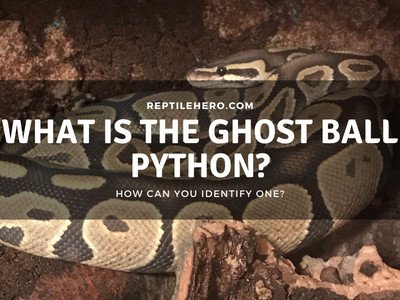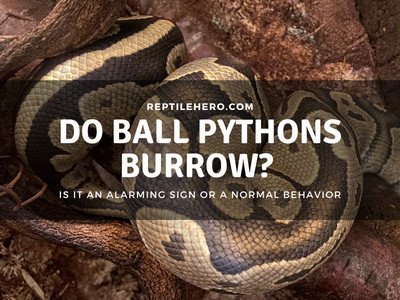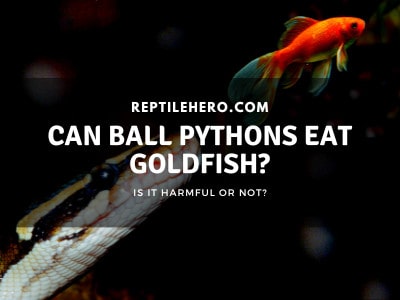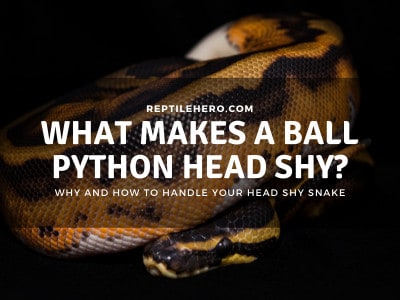Why Does My Ball Python Rub its Face? (5 Reasons!)
Ball pythons look cute especially when doing quirky things like rubbing their face on something. Is this normal though, or should you be worried? Ball python behaviors are sometimes hard to interpret—they could even indicate that there is a problem!
Most of the time, ball pythons rub their face on an object when they are about to shed. But there are instances that it may be caused by stress from husbandry issues, mites infestation, substrate debris, and respiratory infection.
Ball pythons are known as the “pet rock” in the snake-keeping community due to their inactivity and slow movements. However, there are times when they show weird movements like rubbing their nose. What causes this behavior? Find out more as your read below!
1. Shedding
In most cases, ball pythons seen rubbing their faces are triggered because they are about to shed. Ball pythons shed head-first, that is why they rub their head against rough surfaces to loosen up the skin on their face.
So what should you expect when you see your ball python shed for the first time? Check the table below!
| Day | Typical signs |
| 1-2 | Slightly dull skin and pink belly |
| 3-7 | Increasingly dull skin and blueish-gray eyes |
| 7-10 | Loss of dullness and opaque eyes |
| 10-12 | Actual shedding of the old skin |
To ensure a great shed, I recommend maintaining humidity levels around 70-80%.
Increase humidity in the ball python enclosure for successful shedding by:
- Decreasing ventilation
- Increasing water bowl size/quantity
- Replacing the substrate
- Misting regularly
>> Learn more about maintaining proper humidity levels in our article about foggers and misters for ball pythons
Using a humid hide is also great when a ball python is about to shed.
To make a DIY humid box, you can use plastic Tupperware and pierce one hole on top big enough for the ball python to come in.
Then you can use moss or paper towels inside the humid hide which must be moist.
2. Stress
If a ball python is rubbing its face on the walls and glass or acrylic doors of the enclosure, then it might be a sign of stress. This might happen when they have improper husbandry or when relocated.
The most common cause why a ball python wants to get out of its enclosure is improper temperatures. So I recommend making sure that the right temperature is followed and the snake is offered a temperature gradient inside the enclosure.
Below are the recommended temperatures and husbandry standards for keeping ball pythons.
| Husbandry | Recommendation |
| Temperature | 75-93°F (24-34°C) |
| Humidity | 50-70% (80% when shedding) |
| Light duration | 12 hrs per day |
| Enclosure | 4 x 2 x 2 for adults |
| Hides | One for each side (minimum) |
| Water dish | One, big enough for soaking (minimum) |
| Substrate | Coco-substrates, cypress mulch, aspen beddings, bioactive substrate |
Rehomed ball pythons tend to be tensed when placed in a new enclosure. They are often seen rubbing against the walls which means that they are still not comfortable with the new environment.
Frequent rubbing on the sides of the enclosure can cause scale removal and scratches to the nose or mouth of a ball python. If not treated properly, it can cause infections that will need immediate veterinary care.
For minor scratches on the nose or mouth of a ball python, I suggest applying betadine and relocating the snake to a disinfected temporary enclosure. Minor injuries will typically be gone after one shed.
3. Mites
Ball pythons that rub their faces on surfaces can also mean that they have mites. Snake mites are harmful and can be transmitted easily to other snakes.
For treating a mite infestation, I recommend using this from Pro-products. Even though they are harder to find, it is one of the few reptile mite sprays that is USDA and EPA approved for all reptiles.

Warning: When using a mite treatment, it is important to follow exactly the instructions on the product itself. Failure to follow this may lead to the chemicals harming your ball python, especially smaller ones.
If you do not have access to such a mite treatment solution, I suggest soaking your infested ball python in a Dawn dish soap (preferably “Gentle Clean”) and water mixture for about 10-15 minutes. This will not treat your mite infestation but will give some relief to your ball python.
You can also utilize Taurrus predatory mites to prey on the parasitic mites your ball python has [1]. Predatory mites can be an effective alternative to chemicals but will take longer to work compared to the latter.
Taurrus predatory mites will come in a jar that needs to be poured directly on the ball python’s enclosure. They will survive as long as there is moisture and mites in the enclosure.
It is recommended to put the predatory mites as far away from the water bowl as possible because they tend to clump in wet/ humid areas.
What to Do If a Ball Python Has Mite Infestation?
If a ball python’s tank has a mite infestation, keepers should:
- Quarantine the mite-infested ball python in another room for at least 60 days. Use a new enclosure as a temporary one for the snake.
- Use a new hide and water dish for the new quarantine enclosure. I suggest using paper towels treated with Provent-a-mite as a substrate to easily monitor whether or not there are still mites walking around the enclosure.
- Disinfect all things in the enclosure. For the main enclosure, throw the substrate out and disinfect hides and decorations using a dishwashing liquid or a 5% water and bleach mixture. For wooden items, you can bake or boil them to remove any inhabitants like mites.
- Prevent future mite infestation. After the enclosure items have been cleaned thoroughly, use a Provent-a-mite spray for the items inside, following the instructions on the can itself.
- Bring back the ball python. Once everything is dried and there are no signs of any mites inside the main enclosure, then you can put back your ball python after the 60 days of quarantine is over.
Pro Tip: To prevent mites, I suggest quarantining newly bought snakes in another room for 2-3 months. You must also wash your hands properly when attempting to handle your snake and thoroughly clean tools like tongs and gloves when used for multiple snakes.
4. Debris
After eating, ball pythons will sometimes rub their mouths when there is debris in their mouth to remove it. Fine substrates like cocopeat and wood shavings are prone to sticking to their mouths.
This is normal behavior and I personally have seen my ball python, Choco, do this when he gets some bedding in his mouth. He does this when he gets the mice wet and the bedding sticks to its body.
A snake’s digestive fluid is strong and a few bedding won’t be a problem when consumed. The risk of impaction due to the substrate is very rare among snakes.
>> Learn more about constipation and other fecal issues in our article does ball python poop smell?
5. Upper Respiratory Infection
Most of the time, ball pythons that have upper respiratory infections (URI) tend to rub their mouths on something. When they have a URI, ball pythons cannot spit the mucus from their mouths so instead, they rub it on objects to lessen the amount.

When early signs of upper respiratory infections like noisy breathing and saliva discharge are observed, I highly suggest immediate veterinary consultation to give your ball python a higher chance of survival [2].
URIs cannot be cured without using prescribed antibiotics.
The veterinarian will then tell you what to do as the ball python’s treatment maintenance which most probably is: quarantine, medical fogger, and temperature/humidity adjustment.
Pro Tip: When consulting a veterinarian, it is important to ensure that the infected ball python gets tested on the infected part before prescribing any antibiotics needed. Proper bacterial testing will result in the most optimal treatment for the sick ball python.
Do Ball Pythons Like to be Rubbed?
In general, ball pythons do not like getting rubbed. But some may tolerate or show enjoyment for it. Each ball python is different and the response to being stroked will depend on the snake’s temperament.
Petting your ball python can be done but it should be at the right time.
Newly acquired ball pythons must have acclimated in their enclosure before you take them out for handling and rubbing. They also need to eat at least 1 or 2 times to lessen stress when it comes to handling.
In my personal experience, some ball pythons can tolerate getting rubbed like my 6-year-old male ball python Choco. But he does not seem to “love” it per se.
I can consider Choco as a very tame snake. His temperament is slightly shy but will become comfortable with anyone who has picked him up.
Even though he doesn’t show signs of “liking” being rubbed, he can tolerate it very well. So far he has not shown any sign of aggression besides when he is in feeding mode.
Fun Fact: When it comes to snake temperament, ball pythons are one of the most docile and typically won’t bite when picked up. Most wild ball pythons exhibit docile behavior even if they are handled straight from their burrows.
What are the Sweetspots to Rub in Ball Pythons?
Even though each ball python has a different reaction to rubbing, the most common parts they can tolerate being stroked are the spine, belly, chin, and head.
When they are comfortable enough in slithering through your hands, you can test if they can tolerate rubbing starting from their spine, belly, chin, and lastly their heads.
A ball python’s neck and head are its most protected body part which makes it sensitive to getting touched. Ball pythons are born head shy and some might not like being rubbed on there.
>> Learn more about handling head-shy ball pythons in our article why is your ball python head-shy?
On some occasions, it has been observed that if you rub a ball python’s tail it will trigger them to slither faster and flee away from you.
Further Questions
How to stop ball python from nose rubbing?
For naturally occurring processes like shedding and eating, you cannot stop a ball python from rubbing its nose. However, nose rubbing due to causes like stress, mites, and RIs can be prevented with proper husbandry, sanitation, and quarantining.
Can ball pythons get itchy?
Itchiness in ball pythons are generally caused by either shedding or having mites. They typically rub their heads or body against an object when showing signs of being uncomfortable.
Why does a ball python rub its face on me?
If a ball python rubs its face into a human, it mostly does not mean anything. Although, there is a theory that ball pythons rub their face on something they like based on their behavior while mating. But there are no studies to prove this fact.
Why does a ball python rub its face on glass?
If a ball python is seen rubbing its face or nose into the glass, it is a sign that it might want to escape the enclosure. It may want to escape due to husbandry issues or an unclean environment.
Summary of Why Does My Ball Python Rub its Face
Ball pythons rub their faces because of the following: shedding, stress, mites, debris, and respiratory infections. The most common reason is due to shedding.
In general, ball pythons do not like being rubbed except for some that show tolerance or “love” it. There are no studies to prove that they like the affection they get from being stroked.
When rubbing ball pythons the most common areas they tolerate are: the spine, belly, chin, and head. Their head and neck area are the most sensitive since it is their most vulnerable part.







